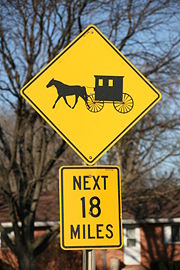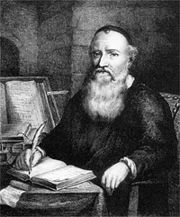The Vidette-Reporter
Iowa City, Iowa
Tuesday, February 19, 1895
Vol. 27, No. 57, Page 1
A Tri-Weekley Nespaper Published by Students of the University of Iowa
"The Amish Mennonites."

TRANSCRIBER'S NOTE: This article was written in 1895 and some of the terminology from that era may not
be considered politically correct in the year 2009.

 The State Historical Society has just published a neat monograph containing a sketch of the Amish Mennonites and their
settlement in Iowa, together with an appendix containing their creed. The author of this monograph is Barthinius L[arson]. WICK,
A.M., '93 [1858-1933], former Fellow in History IA the Univeristy of Iowa. Mr. WICK traces very carefully the early history of this
people, many of whom have formed some of the best citizens of this country.
The State Historical Society has just published a neat monograph containing a sketch of the Amish Mennonites and their
settlement in Iowa, together with an appendix containing their creed. The author of this monograph is Barthinius L[arson]. WICK,
A.M., '93 [1858-1933], former Fellow in History IA the Univeristy of Iowa. Mr. WICK traces very carefully the early history of this
people, many of whom have formed some of the best citizens of this country. The word "Mennonite" takes it origin from
one Menno SIMON (sic, Menno SIMONS (1496-1561)), who proclaimed as a doctrine of peace that the Christian church had no right to defend a creed by
force. The Mennonites, however, ascribe the foundation of their creed to the Waldenses. [NOTE: The Waldenses, or Waldensians or Vaudois, refers to a spiritual
movement of the later Middle Ages which promoted social justice, freedom of conscience, and fostered inter-religious work which advocated a respect for religious
diversity.] The Mennonite movement first made
its appearance in the valleys of the Piedmont, and finally developed into a creed in Holland. Many of the early followers of
Monno SIMON came from the Anabaptists, and extremely religious sect which became very prominent in Germany and the Netherlands
during the Reformation. The Anabaptists passed under various names in different countries. In principle, however, their
creed was the same. They denied infant baptism, imitated the Apostles by going bare-foot, held gloomy views of future
judgment, etc. The object which the Anabaptists sought was to carry on the reform of Martin LUTHER, but their existence as a
distinct sect was of a short duration. The word "Mennonite" is used to designate, not the individual opinions, but the
religious doctrine of the eminent expounder whose name it bears. Meno (sic) SIMON was born in a village in Freisland,
in 1492, consequently he was a contemporary with LUTHER [Martin LUTHER (1483-1546)], MELANGTHON
[Phillip MELANGTHON (1497-1560)], CALVIN [John CALVIN (1509-1564)], ZWINGLE [sic, Huldrych or Ulrich ZWINGLI
(1484-1531)] and other noted reformers of the time.
Meno SIMON renounced the Catholic church, and in 1536, together with eight persecuted followers, he formed the first
society which afterward became known as the Mennonite Society. The history of the society in succeeding years is one of
persecution (sic). In 1632 a synod of this society assembled at Dort and adopted a confession which since that time has
been the recognized creed of the Mennonite church. The Amish or Omish Society was founded by Jacob AMMON (sic), a native of
Switzerland, who later removed to Alsace. [NOTE: Alsace is located on the eastern
border of France, on the west bank of the upper Rhine River adjacent to German and Switzerland.] AMMON's followers were irreverently spoken of as Hookers, because they wore
hooks and eyes on their clothes instead of buttons. For some time previous to AMMON, the confession of 1632 had not been
rigidly adhered to, but with his chief purpose to strictly enforce this ancient ordinancer AMMON, although not possessing the
intellectual qualities of SIMON was, nevertheless, a great leader of men. Since the organization of the first Mennonite church
there has developed a number of divisions, but all of them look upon the Confession of 1632 as the fundamental
doctrine of their faith. The chief differences being only in regard to the prohibition and retention of ancient customs.
Their creed has been practical rather than philosophical. The practice of feet washing; the shunning of expelled members;
denying the rights of settling difficulties by going to law, etc., are strictly enforced. They have always been opposed to
slavery, the use of intonicating (sic) liquors, the use of tobacco, and extravagance in dress. Their present make of
dress is similar to the Dutch peasant of the first half of the sixteenth century. The possession of luxuries is also forbidden.
The early history of Pennsylvania contains largely an early history of the Mennonites in America, Germantown being the
chief center of their spiritual and intellectual life. Persecution in Europe led to their immigration into America. Their
number increased to about fifty-two thousand above the age of sixteen in 1890. Their migration westward took place slowly.
A few took up their abode in Ohio, but it was not until 1840 that a party found their way as far west as Iowa.
They first landed at Burlington, then came to Iowa City, and Cedar Rapids, and back to Chicago. They finally settled in
Goshen, Indiana. Before the end of the year, however, a settlement had been formed near Keokuk, Iowa. Their object for
settling [in] Iowa was because the land was cheap, and for the purpose of carrying out the community plan. In
1845 a party of Amish from the east came to Iowa and finally settled about twenty miles southwest of Iowa City. This nucleus
developed into what is now the largest and most important Mennonite center in the state. Thrift and economy have made them
a properous people. Various other small settlements are to be found throughout the state. Mr. WICK devotes the last
few pages to a comparison of the Amish and Amana Societies. The previous study which the author has made of the
Amana society makes him very familiar with both of these institutions, and the interesting and original comparison which
he makes can be read with considerable profit. The Amish Society is communistic, while the Amana Society may be called a
quasi-community. The members of the Amana Society do not toll hard, and as a rule live longer, being so regular in
their habits. The Amish on the other hand work harder, put in more hours, and get much more work done, but are ignorant
of the Colony motto, "to make work a pleasure, not a pain." The diversity of employments which the Amana Society offers
makes it preferable to the Amish Society, where agriculture is the only employment. By their honesty, temperance, thrift,
and industry, both have won the respect of all. The monograph is concluded with an apendix (sic), "The Dort Confession of
1632," which is their adopted creed. This monograph, written by Mr. WICK, is one which no student should fail to
read. It will be found extremely interesting as well as profitable.
 In the late 15th and early 16th centuries, Friesland was ravaged by war and the land was haunted by Landsknecht
soldiers in an attempt to force the "Free" Frisians to accept the Duke of Saxony-Meissen as the head of state.
In the late 15th and early 16th centuries, Friesland was ravaged by war and the land was haunted by Landsknecht
soldiers in an attempt to force the "Free" Frisians to accept the Duke of Saxony-Meissen as the head of state.
In the early days of the Anabaptist movement, Menno SIMONS, a Catholic priest in the Netherlands, heard of the movement
and started to rethink his Catholic faith. He questioned the doctrine of transubstantiation, but was reluctant to leave
the Roman Catholic Church. His thinking was influenced by the death of his brother, who, as a member of an Anabaptist
group, was killed when he and his companions were attacked and refused to defend themselves. In 1536, at the age of 40,
SIMONS left the Roman Catholic Church. Soon thereafter he became a leader within the Anabaptist movement. He would become
a hunted man with a price on his head for the rest of his life. His name became associated with scattered groups of
nonviolent Anabaptists he helped to organize and consolidate. In 1539, Menno SIMONS wrote, "For true evangelical faith...cannot lay dormant; but manifests itself in all righteousness and works of love; it...clothes the naked; feeds the hungry; consoles the afflicted; shelters the miserable; aids and consoles all the oppressed; returns good for evil; serves those that injure it; prays for those that persecute it."
Jakob AMMANN (a.k.a. Jacob AMMAN) led an effort to reform the Mennonite church: to include shunning (social
avoidance of baptised members who left the church), to hold communion more often, and other differences.
When the discussions fell through, Jacob and his followers split from the Mennonite church. AMMAN's followers became
known as the Amish. The acrimony between the two groups was so severe that they reportedly refused to talk to each other
when they found themselves together on the same boat sailing to America.
 Barthinius L. WICK authored The Amish Mennonites: A Sketch of Their Origin, and of
Their Settlement in Iowa, With Their Creed in an Appendix, 60 pages, published by Iowa State Historical
Society, Iowa City, Iowa, 1894. Mr. WICK authored several other works about Iowa history, which includes:
History of the Amana Society [published by Iowa Historical Society, Iowa City in 1891] and
History of Linn County Iowa From Its Earliest Settlement to the Present Time [two-volume work co-authored with Luther BREWER, published by
Torch Press and The Pioneer Publishing Company, Chicago, 1911], and Did the Norsemen Erect the Newport [RI] Round
Tower?, published by Torch Press, Cedar Rapids, Iowa in 1911.
SOURCES:
The Vidette-Reporter, Feb. 19, 1895, Page 1
en.wikipedia.org/wiki/Menno_Simons
en.wikipedia.org/wiki/Mennonites
en.wikipedia.org/wiki/Jacob_Amman
Transcriptions and compilation by Sharon R. Becker, May of 2009

To submit your Ringgold County obituaries, contact
The County Coordinator.
Please include the word "Ringgold" in the subject line. Thank you.


|


